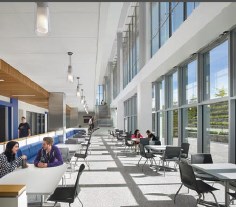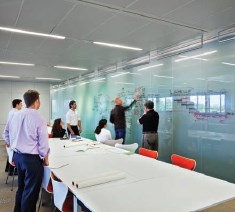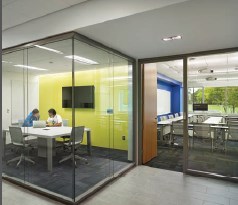by Janice Barnes & Rachel Casanova — Increasingly, today’s organizations are faced with questions about change management, occupant engagement and transition planning. Before diving into who should be leading these initiatives and how to ensure success, it is important to understand the differences between these related but distinct concepts.

Key concepts
Change management is an overarching effort that stems from a decision to make an organizational change, be it physical or otherwise. In order to embrace the change, employees, students, patients and other users of the space must have a firm understanding of:
- What will be changing
- Why it will be changing
- How it will affect the experience or use of space
Once these elements are defined, an action plan should be developed to guide the change — this is referred to as a transition plan. It is tactical. It defines the communication strategy, engagement activities and training that should be provided to deliver successful change.
In many transitions, for example, this requires recognition of other tools and processes that will need to shift in order for the change to be fully implemented. A good first step is defining the future workplace, which includes identifying the myriad practices that will need to adapt in order to support this new workplace. This process includes establishing refined management training and facilitating cross-department/ cross-discipline conversations in order to assure that each work process touched by the new workplace strategy aligns.
Employee engagement is a requisite part of the transition planning process. In particular, engaging employees in ways that are meaningful, authentic and that demonstrate value is critical. This helps make it easier for them to adopt new behaviors and let go of old ones. It is well established that employee engagement can reduce costs, drive greater innovation and problem solving and have a dramatic impact on employee retention.
Overall, an engagement strategy should build trust and understanding in addition to allowing employees to be participants in the process, and more deeply understand how their work will change and why. Consider developing a guide to help employees understand a range of typical building functions, including sustainable design aspects such as refraining from overriding sustainable lighting controls and how to answer customer questions regarding the company’s commitment to sustainability. Through this guide, employees will be able to become more deeply engaged with the facilities they use every day.
Occupant engagement goes beyond an organization’s relationship with its employees; it may relate to the connection between landlord and tenant, a student within a university or a specialized practice joining a larger health network. The point is that a person who is an occupant isn’t always an employee, but can instead be a customer.

As a result of the different relationship, the structure of the change process must adapt. For example, even the most sustainably designed building requires participation from its tenants to achieve its long-term goals. Consider individuals employed by different companies within the same building. Now imagine their habits in regard to turning electronics on and off, interacting with automatic shades, and using stairs and elevators.
The landlord, driven to achieve building performance, must engage those occupants to encourage the desired behavior while managing the landlord/ tenant relationship.
The role of facility managers
Occupant engagement is an integral component of an aligned, well-designed strategy for workplaces, academic buildings, outpatient facilities and critical care hospitals. When any of these spaces is redesigned, the process creates visibility into many other non-spatial parts of the organization. The space becomes an embodiment of the brand and the culture of the organization, and it serves as an enabler for other changes.
There are many case studies over the last 20 years where design was used as the primary catalyst for change in an organization — in the model of “if we build it, they will change.”
However, this model has not been especially successful. Instead, it often creates discord and disengagement if shifts in culture or processes necessitated by the new space do not receive the same attention. Things that are taken away (such as private offices or file cabinets or printers) force people to do things differently. Since facility managers are in the position to create physical changes, this becomes the time that behavioral changes are required. For example: if the file policy has been restated and is now to be completed electronically, people may continue to use the “old way” until the filing cabinets are removed. As a result, today’s facility managers have become change agents, but they’re not alone.
Many different parts of an organization must collaborate for any transition to be a success. Consider the following scenarios: Have your technology tools been replaced in the past year? Have you started scanning paperwork instead of keeping hard copies? Has employee mobility increased, resulting in changes in how everyone interfaces with technology, manages, is managed and relates to colleagues? It goes without saying that all of these changes require support from a range of subject matter experts, including real estate and facilities, operations, human resources, information technology, communications and business leaders. Some organizations also form continuous improvement groups to support complex changes. Notably, the involvement of business leaders cannot be overstated; they are the respected voice within a particular area of practice. Change is hard. Without leadership voice, success is much harder to attain.
Where to start
With any organizational change, initial assessment will help prioritize areas of focus. Consider the following factors as you assess the greatest needs:

- Voice — People want to hear from someone they respect and follow. Leaders need to have an active role in communicating and reinforcing the message. Remember that these leaders may be representatives of the management team, but they may also be found within the organization without a title that defines a leadership role; these individuals should be identified and engaged deliberately.
- Degree of change being experienced — If an organization is making major changes in the way that it works, whether physical or not, the need for support (and the duration of that support) is significantly greater than if the organization is maintaining its existing business model. If there are multi-disciplinary changes happening, then a team must be formed to work together. IT experiences changes very differently than human resources or real estate. These differences must be seen holistically and approached with a comprehensive change management strategy.
- Stakeholder characteristics — People are unique. Knowing your audience and their hot buttons, pain points and interests is key to creating positive change.
- Decision-making structure and authority — This further addresses stakeholders and specifically how decisions are made. A more centralized organization structure may require less consensus building than one where authority is decentralized, for example at academic institutions or mission-based organizations.
- Revenue impact — If there is a measurable business impact, change is easier to understand from all aspects of the organization. If brand realignment or qualitative issues are driving the change, it is often comparatively harder. Clear examples include retail environments, where every cubic foot might change a sale, or college dormitories, where square footage directly relates to quantity of rooms available for new students. When there are direct links to revenue generation or capacity to serve customers, the effect of the change can be more easily calculated and communicated.
- Risk factors — Changes that pose high risk, whether to attention or business continuity, need to be treated differently. For example, in a health care setting where new equipment or procedures are to be implemented, it is absolutely necessary to understand how routines will be interrupted and what potential risk this will have on patient safety. Routines are part of the healthcare delivery cycle, but interrupting them by designing new environments, installing new equipment or altering existing procedures creates new risks.
- Investment calculations — Often these calculations occur through different departments in the organization; the overall ROI can only become clear through holistic examination (real estate cost reductions against technology investments).
- Success factors — Success factors vary by group and by individual, which can make measurement of success difficult until shared values are identified and basic factors are aligned. Defining how those measures relate to the key influencers in the change process is also a critical step.
- Technology evolution — There is a wide range of capabilities to the technology backbone. If an organization intends to create new ways of working, for example, there will be significant changes to the technology backbone, the infrastructure investment and ultimately the human interface with the tools.
Based on these indicators, the tactics deployed in the transition plan and the processes of employee and occupant engagement will vary. While no single set of tactics works for all organizations, there are some basics to consider:
Messaging
- Consistent, branded messaging brings context to all forms of communication about the change, such as in presentations and newsletters.
- Messages and materials that come from leadership convey significance in communications.
- Online newsletters often offer a convenient channel for communicating a variety of update.
Input
- Online crowd-sourced feedback mechanisms, such as websites or pulse surveys, provide a way to receive real-time insights as well as a continuous opportunity for engagement.
- Interviews, focus groups and facilitated workshops provide a chance to gather data as well as an opportunity for users to be heard one-on-one.

Experience
- “Day in the life” animations, story boards or other depictions help provide a user-centric perspective of the change ahead.
- Technology showcases create an opportunity to try the new technology that often accompanies a change to space before it is deployed.
- Training for specific skills alleviates the fears that often accompany the introduction of unfamiliar new tools.
- Site tours provide great benefit by giving users an experience of the space.
- It is worth noting that any tactics that are necessary for “how-to” often are paired with others that focus on “why we should.” This will improve the effectiveness of any engagement and help to ensure accurate representation of an organization’s unique characteristics.
Ongoing engagement
In many ways, the occupant engagement process is never done, but how the process is managed evolves as capabilities increase. Begin a change management approach with the development of a new workplace strategy, continue with prototyping and roll-out at multiple locations if applicable and then arrange for the measurement and ongoing monitoring of performance. In this most recent stage, employees inside the organization can be trained to carry the program forward as an integral part of their business as usual approach. Additional training may need to be developed and offered as time goes on, but getting the employees involved in a practical way throughout their day helps ease the transition.
It is critical to remember that occupant engagement is about getting users to have a positive connection to a new normal that accompanies a change in space design. This positive connection is rarely formed by talking at people. It happens when users make the connection to the drivers for change, understand their individual role in the change and understand the intent. Think about a change you’ve experienced — did it feel like it was done to you or with you? We want to be asked. We want to influence our surroundings to make them work for us as individuals.
As facility managers, designers, architects, planners and managers, we have a significant responsibility and opportunity to embrace our role in the success of our organizations well beyond the management of space. Enjoy the journey and make it fun — after all, you can catch more flies with honey than vinegar.

Janice Barnes, Ph.D., LEED AP BD+C, is Perkins+Will’s global leader of planning and strategies. In this capacity, she focuses on the ways in which planning enables clients to meet their business goals. With more than 20 years of design experience and a significant research background, Barnes recognizes the critical aspects of business processes and links these to appropriate organizational responses, ultimately helping clients to make better decisions.
Internationally recognized for her expertise in workplace and organizational strategy, Barnes leads the firm’s annual workplace trends research. She also leads engagements with diverse clients such as the United Nations, Medtronic, TD Financial Group and KPMG.

Rachel Casanova, LEED AP ID+C, is a senior planning and strategies consultant with nearly 20 years of experience in helping companies transform their real estate assets in order to reinforce long-term business strategies, corporate culture and increasingly integrated space, technology and performance goals. Her portfolio spans strategic and occupancy planning, programming and workplace standards development and also includes deep expertise in change management for today’s evolving workplaces.
Casanova works closely with her clients, including Kimberly-Clark, MetLife, Thomson Reuters and Trinity Real Estate, to help them refine their business objectives and respond with a workplace that is tailored to their needs.